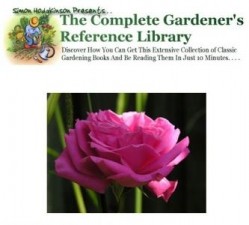 License Type: Resell Rights
License Type: Resell Rights  File Size: 5,641 KB
File Size: 5,641 KB File Type: ZIP
File Type: ZIP
 SKU: 16503
SKU: 16503  Shipping: Online Download
Shipping: Online Download
Ebook Sample Content Preview:
Even the smallest patio, balcony, courtyard, roof terrace or porch can boast a crop of vegetables or a garden of flowers, all achievable by planting them into containers. In larger gardens they may be used to enliven dull spots in borders, as eye-catchers to close vistas, as pointers around the garden, to draw attention to a particular area or simply as decorative ornaments. Planted containers are useful to mark an entrance, such as either side of a doorway or positioned on gate piers, to furnish a terrace, patio or outside sitting or eating area, to line a pathway as a means of introducing a note of formality.
There is hardly anything, which cannot be grown in a pot – including trees and shrubs. Container planting allows tender plants to be moved to shelter for winter protection. A greenhouse, conservatory or even frost-free garage can be used to protect them in the colder months. Containers which must stay out of doors all the time can be separately planted for winter and summer, or have a permanent colony of staple plants to which seasonal extras are added. When used in groups, pots in varying sizes and heights look best, this works well especially in small areas such as a courtyard or terrace where the illusion of a lush garden is desired. Once the plants are growing well, producing lots of foliage and flowers, many of the containers will not be visible, creating the visual effect of well-stocked borders.
At first sight creating a green paradise out of a few square yards of empty space may seem a daunting prospect, but with imagination and some know-how even the most unpromising gloomy corner can be transformed into a delightful garden area, offering a place of repose amid the bustle of daily life. A small terrace can be given a warm and intimate character with brightly coloured plants.
Climbers planted in pots from which they are able to scrambling up walls, and wall fixed planters containing cascading plants will decorate the plainest of facades. Planter boxes, urns, wooden barrels, hanging baskets and large flowerpots are just some of the containers that can be used. The container gardener is limited only by his imagination. Consider the following guidelines when choosing your container. Avoid containers with narrow necks.
Cheap plastic pots may deteriorate in UV sunlight and terracotta pots dry out rapidly. Glazed ceramic pots are excellent choices but make sure your pot has adequate drainage. Holes should be 1/2 inch across. Line the base of the pot to prevent soil loss. The best medium for this is polystyrene chips, these do not add weight to the pot, important if you intend to move the pots around, or are to be sited on a roof garden or balcony. Filling deep containers with a good depth of the chips avoids the need to add more compost than is necessary for those shallow rooting plants; it also reduces the over-all weight.
Wooden containers are susceptible to rot. Redwood and cedar are relatively rot resistant and can be used without staining or painting. Avoid wood treated with compounds such as creosote, these are toxic and can damage the plants. One advantage of wooden containers is that they can be built to sizes and shapes that suit the location.
Remember that small pots restrict the root area and dry out very quickly. The size and number of plants to be grown will determine the size of the containers used.
- File Size:5,641 KB
- License: Resell Rights
- Category:Ebooks
- Tags:2008 Ebooks Resale Rights








